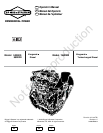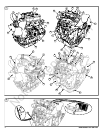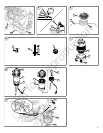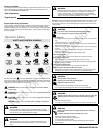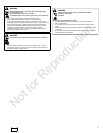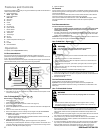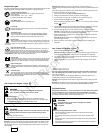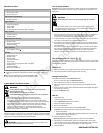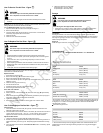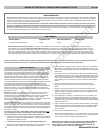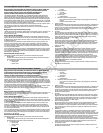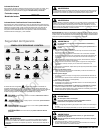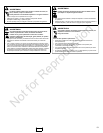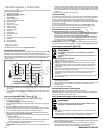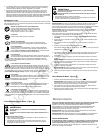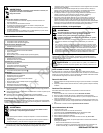
8
BRIGGSandSTRATTON.COM
Maintenance Chart
Every8HoursorDaily
• Check engine oillevel
• Check coolant level
First 50 Hours (initial Break- In)
• Change engine oil *
Every 100 Hours
• Check fan belt tension
• Clean radiator
• Clean air filter
• Check muffler and cleanspark arrestor (if equipped)
Every 150 Hours
• Change engine oil *
• Replace oil filter
Every 600 Hours or Annually
• Replace air filter
• Check valve clearanceH
• Replace fuel filter
Y
Every 1500 Hours
• Check injection nozzles z
Annually
• Change engine oil *
• Replace oil filter
• Change coolant
• Check fan belt tension
• Clean radiator
• Check muffler and cleanspark arrestor (if equipped)
• Replace air filter
• Replace fuel filter
Y
• Check valve clearanceH
* Service more often when operating under heavy load or inhigh temperature.
Y
Follow the manufacturer’s maintenance schedule if non-Briggs & Stratton part is
used.
z Service must be performedby an authorized DENSO dealer.
H Not required unless engine performance problems are noted.
Inspect Muffler And Spark Arrester
Running engines produce heat. Engine parts, especially muffler,
become extremely hot.
Severe thermal burns can occur on contact.
Combustible debris, suchas leaves, grass, brush, etc. can catchfire.
WARNING
• Allow muffler, engine cylinderand fins to cool before touching.
• Remove accumulated debris from muffler area and cylinder area.
• It is aviolation of California Public Resource Code, Section 4442, to use or
operate the engineon any forest-covered, brush-covered, or grass-covered land
unless the exhaust system is equipped with a spark arrester, as defined in
Section 4442, maintainedin effective working order. Other states or federal
jurisdictions may havesimilar laws. Contact t he original equipment
manufacturer, retailer, or dealer to obtain a spark arrester designed for the
exhaust system installed on this engine.
Inspect the muffler f or cracks, corrosion, or other damage. Remove thespark arrester, if
equipped, and inspect for damage orcarbon blockage. If replacement parts are required,
make sure to use only original equipment replacement parts.
WARNING: Replacement parts must be the same andinstalled in the
same position as the original parts or fire could result.
How To Check Coolant
Important: Thisis a liquid cooled engine. A 50/50% coolant mixture of phosphate-free
antifreeze and tap water is required for cooling, rust resistance, and lubrication of the
water pump.
Severe thermal burnscan occur by escaping steam or hot coolant.
WARNING
• DO NOT remove radiator cap or reservoir cap if engine is warm or running.
• Stop engine and allow it to cool before removingradiator cap or reservoir cap
and before c hanging or adding coolant.
1. Check the coolant level. The coolant level must be between the FULL and LOW, or
ADD, marks on the coolant reservoir. If thecoolant level is low, add a 50/50%
coolant mixture of phosphate-free antifreeze andtap water to the reservoir.
2. To removethe reservoir cap after engine iscool, place a thick cloth over the reservoir
cap. Slowly turnthe reservoir cap counterclockwise to remove.
3. If the reservoir is dry, add coolant to both the reservoirand to the radiator. See the
equipment manual forlocation, operation, and maintenance of the coolant reservoir
and of theradiator.
4. To remove the radiator cap after engine is cool, place a thick cloth over the radiator
cap. Slowly turnthe radiator cap counterclockwise to the first stop. Ifpressurized
steam escapes from the cap, standback to avoid injury. After all pressure is
released, push downand turn the radiator cap counterclockwise to remove.
How To Change The Oil - Figure
2 3
Used oil is a hazardous waste product and must be disposed of properly. Do not discard
with household waste. Check with your local authorities, servicecenter, ordealer for safe
disposal/ recycling facilities.
Remove Oil
1. Remove the oil drain plug (G, Figure 3). Drain the oil into an approvedcontainer.
2. After the oil has drained, install and tightenthe oil drain plug.
Change The Oil Filter
For replacement intervals, see the Maintenance chart.
1. Drain t he oil from the engine. See Remove Oil section.
2. Remove the oil filter (H, Figure 3) and dispose of properly.
3. Before you install the new oil filter, lightly lubricate the oil filter gasket with fresh,
clean oil.
4. Install the oil filter by hand until the gasket contacts the oil filter adapter, then tighten
theoilfilter1/2to3/4turns.
5. Add oil. See Add Oil section.
Add Oil
• Place engine level.
• Clean the oil fill area of any debris.
• See the Specifications section for oil capacity.
1. Remove the dipstick (A, Figure 2).
2. Remove the oil fill cap (J).
3. Pour the oil slowly intothe engine oil fill (C). Do not overfill.
Important: Whenadding oil, adequate venting is required as follows:
• Remove the dipstick.
• Make sure adequateclearance (D) is maintained between the oil fill device (E)
and the engine oil fill (C).SeeFigure4.
4. Install and tighten the oil fill cap.
NOTICE: Before starting the engine, wipe the engine clean of any spilled oil.
5. After adding oil, install the dipstick. Start and run engine at idle for five minutes.
Check for leaks. Shut off engine. Wait three minutes and check oil level. If required,
add oil to bring oil level tothe FULL mark (B) on the dipstick (Figure 2).
6. Install the dipstick.
Not for Reproduction



